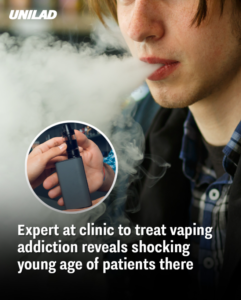The rise in youth vaping has led to the establishment of specialized clinics addressing nicotine addiction among minors, revealing alarming trends in the age of affected individuals. A pioneering example is the clinic at Alder Hey Children’s Hospital in Liverpool, UK, which has begun treating patients as young as 11 years old.
Early Onset of Vaping Addiction
Professor Rachel Isba, leading the initiative at Alder Hey, has highlighted the concerning prevalence of vaping among young children. She notes that many patients report using vapes shortly after waking, indicating significant nicotine dependence. The clinic employs nicotine replacement therapies, such as patches and gum, tailored to each child’s addiction level.
Factors Contributing to Youth Vaping
Several factors contribute to the rise in youth vaping:
-
Appealing Flavors and Packaging: E-cigarettes often feature sweet flavors and colorful designs that attract children. Despite legal prohibitions on selling vapes to individuals under 18 in the UK, these products remain accessible.
-
Perceived Harmlessness: Many adolescents underestimate the addictiveness of nicotine and the potential health risks associated with vaping. This misperception can lead to experimentation and subsequent addiction.
Health Implications
The health effects of vaping on developing bodies are a significant concern:
-
Nicotine Addiction: Early exposure to nicotine can result in long-term addiction, with adolescents being more susceptible due to ongoing brain development
-
Physical Health Risks: Vaping has been linked to lung damage, pneumonia, dizziness, and vomiting. In England, there has been a notable increase in hospital admissions among under-18s for vaping-related illnesses. Challenges in Treatment
Treating vaping addiction in youth presents unique challenges:
-
Lack of Standardized Treatments: There are no established treatment protocols specifically for youth vaping addiction. Clinicians often adapt adult smoking cessation methods, such as nicotine replacement therapies, despite limited evidence of their effectiveness in adolescents.
-
Continuous Use Patterns: Unlike traditional cigarettes, e-cigarettes can be used continuously, leading to higher nicotine intake and making cessation efforts more complex.
Preventative Measures and Support
Addressing youth vaping requires comprehensive strategies:
-
Regulatory Actions: Implementing stricter regulations on the sale, advertising, and packaging of e-cigarettes can reduce their appeal and accessibility to minors.
-
Education and Awareness: Educating young people about the risks of vaping and nicotine addiction is crucial. Resources from organizations like the American Lung Association provide valuable information for teens and parents.
-
Support Services: For those seeking help, services like SAMHSA’s National Helpline offer confidential support and treatment referrals for individuals facing substance use disorders.
Conclusion
The emergence of vaping addiction clinics treating patients as young as 11 underscores the urgent need to address this public health issue. Comprehensive approaches involving regulation, education, and tailored treatment are essential to combat the rising trend of youth vaping and its associated health risks
